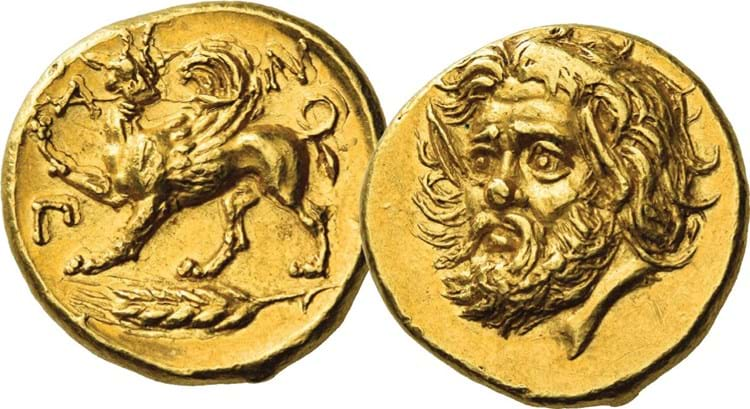
Two views of the Panticapaeum gold stater c.350-300BC sold for SFr4.4m (£3.92m) at Swiss classical coin specialist Numismatica Ars Classica.
The only specimen of this issue in private hands, it sold for SFr4.4m (£3.92m) at Zurich classical coin specialist Numismatica Ars Classica on May 18-19.
The Panticapaeum stater is considered a miniature masterpiece of classical art.
Conservative politician and rare coin collector Godfrey Locker-Lampson (1875-1946) wrote of this issue: “That so much expression could be packed into so small a round would not be believed by anyone who had not seen it… If a single coin had to be selected, as by the greatest of all die-engravers, whoever he may have been, whose work had lasted to the present day, the writer would choose this one.”
Near-perfect strike
It features the head of a satyr on its obverse side, and a griffin with a spear in its mouth on the reverse. The satyr, unusually shown facing three-quarters left, is thought to be a punning reference to the Spartocid king Satyros I, while the griffin alludes to the mythical beasts thought to guard the gold found in the mountains of Scythia.
The 20th century history of this specimen, considered a near-perfect strike, is well documented.
Sold by the Soviets in an auction of the duplicates from the Hermitage Museum in 1934, it was later part of the magnificent collection of Greek coins assembled by French industrialist Charles Gillet (1879-1972).
Prospero sale
The stater last appeared at auction in January 2012 as part of the Prospero sale conducted by a consortium of three firms (AH Baldwin & Sons, Dmitry Markov and M&M Numismatics) in New York.
It made a record price of $3.25m (£2.21m) and was one of many lots in the sale bought by the art collector Sheikh Saud Bin Mohammed Al-Thani (1966-2014).
When he failed to settle his $19.7m bill for Prospero, some of his assets were frozen by the High Court.
The new record price, which is around SFr5.4m (£4.8m) with 22.5% premium added, surpasses the £2.7m (£3.25m with premium) bid at Roma Numismatics in London in October 2020 for a Brutus Eid Mar-type gold aureus, struck shortly after the murder of Julius Caesar.
The validity of that record has since been questioned after the coin was seized in January this year as part of an investigation into Richard Beale, the owner and managing director of Roma.
It has been alleged that the coin’s provenance to a 19th century Swiss aristocratic collection was fabricated.














